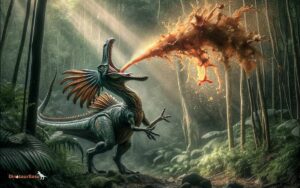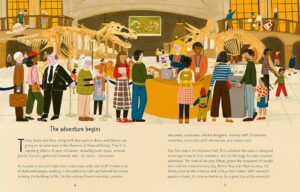How Do Dinosaurs Fit Into the Bible
In a world where dinosaurs are often relegated to children's books and blockbuster movies, one might wonder how these ancient giants navigate the narrow passages of the Bible.
Professionals within theology and science circles have long grappled with the conundrum of fitting these prehistoric creatures into the biblical timeline, exploring theories from Young Earth Creationism to the Day-Age Theory.
The intersection of fossils and faith raises intriguing questions about the compatibility of scientific discovery and religious texts. This discussion invites a deeper exploration into how, or if, dinosaurs and the Bible can coexist, offering a unique lens through which to examine both the past and one's beliefs.
Key Takeaways
- Young Earth Creationism suggests dinosaurs coexisted with humans, challenging conventional scientific timelines.
- The Gap Theory and Day-Age Theory integrate scientific evidence of dinosaurs with biblical narratives, promoting harmony between faith and science.
- Biblical creatures like Leviathan and Behemoth may symbolize dinosaur-like beings, reflecting ancient understanding of these creatures.
- Interdisciplinary approaches to ancient texts and scientific discoveries enrich our understanding of dinosaurs in the context of biblical history.
Historical Context of Dinosaurs
The historical context of dinosaurs, dating back over 230 million years, reveals a complex narrative of evolution and extinction shaped by Earth's changing environments. These magnificent creatures, ranging from the towering Brachiosaurus to the fearsome Tyrannosaurus Rex, thrived across various epochs, adapting to shifting climates, landscapes, and ecological niches.
Their dominance for over 160 million years speaks to an unparalleled adaptability and diversity, reflecting nature's relentless drive towards complexity and survival. The sudden disappearance of dinosaurs, following a catastrophic event around 65 million years ago, marks a poignant chapter in Earth's history, offering valuable insights into the fragility of life and the forces driving evolutionary change.
This analysis respects the quest for understanding the inherent freedom within nature's laws, guiding our exploration of the past to inform the present and future.
Biblical Timeline Explained
Understanding the biblical timeline requires delving into ancient texts that span centuries, offering a unique perspective on history as interpreted through religious and cultural lenses. This timeline isn't a straightforward chronology but a complex tapestry woven from various genres, including poetry, prophecy, and historical narrative. Analyzing it, one finds:
- Creation narratives, which lay the foundational myths and theological concepts of the world and humanity.
- The history of the Israelites, detailing their origins, exodus, monarchy, exile, and return.
- Prophetic writings, offering both warnings and hopes for the future.
This structure invites readers to explore the intertwining of divine interaction with human history, demanding a nuanced understanding of its spiritual and temporal dimensions. It's a journey through time, guided by faith, scrutinized by scholarship, and cherished by believers seeking deeper insights into their heritage and beliefs.
Young Earth Creationism
Exploring the biblical timeline brings us to Young Earth Creationism, a perspective arguing that the Earth and all life on it were created by God approximately 6,000 years ago.
This view interprets the Genesis creation account literally, suggesting a concise, six-day creation process. Proponents meticulously analyze genealogies in the Bible to estimate the Earth's age, aligning historical events within this young timeframe.
They often challenge conventional scientific dating methods, advocating for alternative interpretations of geological and paleontological evidence that support their thesis. Young Earth Creationists argue that dinosaurs coexisted with humans, pointing to certain biblical passages they interpret as references to these creatures.
This approach demands a reevaluation of mainstream scientific assumptions, inviting a dialogue that respects both faith-based convictions and the pursuit of knowledge.
The Gap Theory
Contrary to Young Earth Creationism, Gap Theory proposes a significant hiatus between the first two verses of Genesis, suggesting an ancient Earth pre-dating human creation. This interpretation allows for a harmonization of biblical texts with scientific evidence indicating an Earth billions of years old. Proponents of Gap Theory argue that this period could accommodate the existence of dinosaurs and other prehistoric life, reconciling scripture with paleontological findings.
- Scriptural Interpretation: It posits a gap of undefined time between the creation of the universe and the world as humanity knows it.
- Reconciliation with Science: It offers a framework to integrate scientific discoveries of Earth's ancient past without contradicting the Genesis account.
- Theological Implications: It maintains the infallibility of scripture while embracing the complexity of God's creation.
Day-Age Theory
While Gap Theory offers one approach to harmonizing biblical accounts with scientific evidence, Day-Age Theory presents an alternative interpretation, suggesting that the 'days' in Genesis represent long periods of geological time rather than literal 24-hour periods. This viewpoint allows for a reconciliation between the biblical narrative and scientific understanding of Earth's ancient past, including the age of dinosaurs.
| Interpretation | Biblical Reference | Scientific Correlation |
|---|---|---|
| Day 1 | Light and Darkness | Big Bang and cosmic background radiation |
| Day 4 | Sun, Moon, Stars | Solar system formation |
| Day 6 | Creation of Animals | Cambrian Explosion and subsequent diversification |
Advocates argue that this approach respects both the text's divine inspiration and the integrity of scientific inquiry, promoting a harmonious relationship between faith and reason.
Dinosaurs in Ancient Texts
Exploring the presence of dinosaurs in ancient texts requires a critical examination of biblical creatures' interpretations and a comparison with historical records. Scholars often debate the accuracy and context of these ancient descriptions, questioning whether they align with known paleontological evidence.
This analysis not only enriches our understanding of historical narratives but also challenges us to consider the intersection between science and ancient literature.
Biblical Creatures' Interpretations
Often, scholars and theologians debate the presence of dinosaurs in ancient texts, including the Bible, through various interpretations of biblical creatures. Their analyses hinge on detailed examinations of scriptural references, leading to diverse viewpoints on whether these ancient texts mention dinosaurs directly or metaphorically.
Key points in these discussions include:
- Behemoth and Leviathan: Some argue these creatures, described in Job and Psalms, might be dinosaurs, given their formidable descriptions.
- Symbolic Interpretations: Others see these references as symbolic, representing chaos, evil, or strength, rather than literal dinosaurs.
- Linguistic Challenges: The translation and interpretation of ancient Hebrew texts present significant challenges, complicating efforts to identify any references to dinosaurs accurately.
This scholarly inquiry underscores a broader quest for understanding, respecting the complexity of ancient texts while exploring their relevance to modern questions about history and faith.
Historical Records Comparison
Analyzing ancient texts reveals that references to creatures resembling dinosaurs are not exclusive to the Bible but appear across various cultures and civilizations. Scholars often compare these descriptions, seeking to understand the broader context of such mentions. These comparisons offer insight into how ancient societies might have perceived and integrated the concept of large, mysterious creatures into their worldviews and narratives.
| Culture | Text Reference | Description |
|---|---|---|
| Mesopotamian | Epic of Gilgamesh | Large creatures with scale-like skin |
| Chinese | Classic of Mountains and Seas | Dragons that might resemble dinosaurs |
| Indian | Mahabharata | Giant creatures with descriptions similar to dinosaurs |
This table illustrates a cross-cultural recognition of dinosaur-like creatures, suggesting a global awareness or interpretation of such beings in ancient times.
Leviathan and Behemoth
In biblical texts, the entities Leviathan and Behemoth have sparked considerable debate regarding their identity and symbolism. Scholars and theologians have pondered their existence and descriptions, leading to a variety of interpretations. These creatures are mentioned in the context of divine power and the natural world's wonders.
- Leviathan is often seen as a massive sea creature, embodying chaos and strength.
- Behemoth, on the other hand, is typically viewed as an immense land animal, symbolizing land's untamable nature.
- Both are used to demonstrate God's sovereignty and the limits of human understanding.
Their descriptions in scripture don't directly align with any known animals, leaving their true nature as a subject of fascination and debate. This ambiguity invites readers to explore the depths of biblical metaphor and the mysteries of creation.
Symbolism in Scripture
As the discussion transitions to symbolism in scripture, it's crucial to examine how metaphorical creatures are explained and ancient descriptions decoded. This analysis not only sheds light on the textual significance of such beings but also offers insights into the cultural and historical contexts that influenced their inclusion.
Metaphorical Creatures Explained
Throughout scripture, symbolic creatures serve as powerful metaphors to convey complex spiritual truths and moral lessons. These beings, though not literal in their existence within the texts, embody deep allegorical significance. This approach allows readers to explore layers of meaning that resonate on a personal and communal level.
- Leviathan and Behemoth often depict chaos and strength, challenging readers to contemplate the power of God and the nature of evil.
- The Serpent in Genesis represents temptation and sin, offering insights into human nature and moral failings.
- Four Living Creatures in Revelation symbolize the attributes of God, encouraging a reflection on divine nature and human aspiration toward holiness.
Ancient Descriptions Decoded
Decoding ancient descriptions within scripture reveals a deeper layer of symbolism, inviting readers to uncover spiritual truths woven into the fabric of religious texts. Scholars meticulously analyze these texts, recognizing that every creature mentioned is not merely a literal entity but a representation of deeper moral and spiritual lessons. This approach respects the complexity and depth of ancient writings, providing a bridge to understanding timeless truths.
| Symbol | Interpretation | Spiritual Significance |
|---|---|---|
| Lion | Courage, Power | Divine protection, strength |
| Water | Life, Renewal | Spiritual cleansing, rebirth |
| Serpent | Temptation, Evil | The struggle against sin |
| Dove | Peace, Purity | Holy Spirit, innocence |
This table exemplifies how symbols translate into profound spiritual meanings, offering freedom in interpreting these ancient texts in a way that resonates with contemporary seekers of wisdom.
Scientific Evidence and Interpretation
The interpretation of scientific evidence reveals no direct references to dinosaurs in the biblical texts, challenging the notion of their explicit mention in ancient scriptures. Scholars and researchers have engaged in extensive analysis to understand this discrepancy, which highlights:
- The need for a metaphorical or allegorical interpretation of certain biblical passages.
- The importance of contextualizing biblical narratives within the historical and scientific knowledge of the era.
- The role of continuous dialogue between theology and science in enriching our understanding of ancient texts.
This scholarly approach respects the integrity of both scientific evidence and religious texts, fostering a space where questions of faith and fact can coexist. It emphasizes the importance of open-mindedness and inquiry in the pursuit of knowledge, ensuring that interpretations remain both informed and respectful.
The Role of Fossils
Building on the interplay between theology and science, fossils emerge as pivotal in exploring the presence of ancient creatures in biblical narratives. These remnants serve as tangible links to a world before recorded history, offering a unique lens through which to view the scriptural accounts.
Scholars delve into the sedimentary layers, extracting clues not only about the creatures' physical characteristics but also their habitats and behaviors. This rigorous analysis enhances our understanding of how these ancient beings could fit within the biblical timeline.
Fossils don't just speak of extinction; they whisper tales of creation, adaptation, and the complexity of life on Earth. They stand as silent witnesses, challenging us to reconsider our interpretations of sacred texts in light of scientific discoveries, without stepping into the realm of reconciling science and faith directly.
Reconciling Science and Faith
In navigating the complex terrain between science and faith, scholars seek to find a harmonious balance that respects both the empirical evidence of the natural world and the spiritual insights offered by religious texts.
This endeavor involves:
- Interpreting ancient scriptures in a way that complements, rather than contradicts, scientific discoveries.
- Encouraging open, respectful dialogues between religious and scientific communities.
- Exploring the metaphorical and allegorical layers within religious texts to uncover deeper meanings that resonate with contemporary scientific understanding.
Theological Implications
The inclusion of dinosaurs in creation narratives presents a complex intersection between faith and scientific discovery, challenging traditional interpretations of sacred texts. Scholars argue that this juxtaposition necessitates a reevaluation of how ancient scripture is contextualized within the realm of modern science.
This dialogue opens avenues for a deeper understanding of divine creation, encouraging a harmonious relationship between religious belief and empirical evidence.
Dinosaurs in Creation Narratives
Several theological interpretations explore how dinosaurs might fit within biblical creation narratives, sparking debates among scholars and believers alike. The discussions hinge on reconciling the existence of these ancient creatures with scriptural accounts, leading to a variety of perspectives:
- Some propose that dinosaurs were part of the original creation, living alongside early humans before becoming extinct due to catastrophic events.
- Others suggest that references to 'behemoths' or 'leviathans' in the scriptures might indeed be allusions to dinosaurs, implying their inclusion in the divine plan.
- A further viewpoint considers the possibility that the days of creation weren't literal 24-hour periods but rather lengthy epochs, allowing for the existence of dinosaurs in a pre-Adamic era.
These interpretations underscore the complexity of integrating scientific findings with faith-based narratives, demonstrating a continuous quest for understanding within the religious community.
Faith Versus Scientific Discovery
Faith-science dialogue often confronts the challenge of integrating scriptural beliefs with empirical evidence, particularly in discussions about the existence and timeline of dinosaurs. This interplay between faith and scientific discovery raises profound theological implications.
Believers seeking to reconcile their scriptural interpretations with paleontological findings may find themselves at a crossroads. However, this intersection doesn't necessitate a departure from faith or a dismissal of science. Instead, it invites a nuanced exploration where theological perspectives can evolve in response to scientific advancements.
Perspectives on Extinction
Understanding perspectives on extinction involves examining how interpretations of ancient texts intersect with scientific theories on the disappearance of species such as dinosaurs. This analysis reveals a complex dialogue between faith and science, where each offers unique insights into the natural world's history.
- Theological interpretations often view extinction events within the framework of divine plan or judgment.
- Scientific theories, such as the asteroid impact hypothesis, provide a naturalistic explanation for the sudden mass extinction of dinosaurs.
- Some scholars attempt to reconcile these views, suggesting that both divine providence and natural processes can coexist within a unified understanding of Earth's history.
This blend of perspectives encourages a respectful, scholarly exploration where faith and science contribute to a fuller comprehension of the mysteries surrounding extinction.
Conclusion
In conclusion, fitting dinosaurs into the biblical narrative is a bit like trying to squeeze a diplodocus into Noah's Ark—complicated, but not without its believers.
From Young Earth Creationism to the Day-Age Theory, interpretations vary as widely as the Mesozoic era's biodiversity. While the role of fossils might stump some, others see them as Earth's ancient puzzles, inviting both science and faith to the table.
Ultimately, whether through gaps, days, or divine mysteries, the quest to reconcile these colossal creatures with scripture reveals an enduring human curiosity, blending scholarly rigor with a wink.




